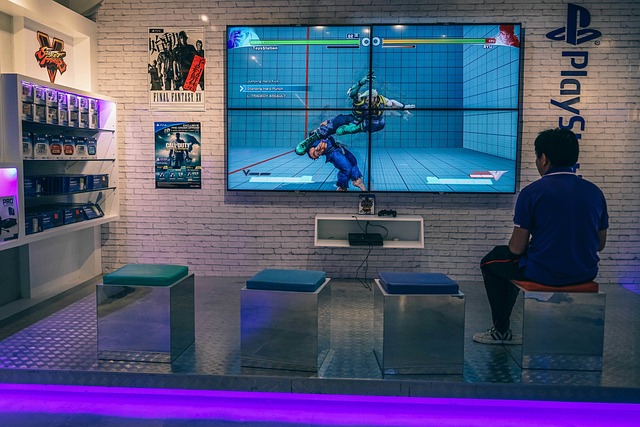Iterative game design relies on active listening to player feedback about mechanics and aesthetics, fostering community engagement. Categorize comments, prioritize issues, fix core mechanics, manage expectations, and analyze trends to enhance retention. Incorporating feedback through clear communication, updates, and interactive polls improves gameplay, caters to diverse players, and encourages loyalty.
In the dynamic realm of game design, player feedback is a powerful tool for refining and enhancing gameplay experiences. This article provides a strategic roadmap for effectively handling player input, from active listening to continuous post-update assessments. Learn how to categorize concerns, validate pain points, implement insightful changes, and communicate revisions clearly. Discover the art of balancing player expectations and creative vision through practical steps tailored to optimize your game’s success.
- Listen Actively to Player Feedback
- Categorize and Prioritize Concerns
- Validate and Understand Pain Points
- Implement Changes Based on Insights
- Communicate Revisions Effectively
- Continuously Gather Post-Update Feedback
Listen Actively to Player Feedback

Effective game design is an iterative process that heavily relies on listening actively to player feedback. When players engage with your game, they bring their unique experiences and perspectives to the table. By cultivating a culture of open communication, you can gather valuable insights into what excites them, frustrates them, or confuses them within the game’s mechanics and aesthetics. This two-way dialogue allows for continuous improvement, ensuring that the final product aligns with the players’ expectations and desires.
Furthermore, actively listening to feedback fosters a sense of community around your game. Players who feel heard are more likely to become advocates, providing public speaking tips on how to share their experiences positively. Engaging with their comments, addressing concerns, and implementing well-reasoned suggestions can transform potential critics into loyal fans. This process also helps in navigating sustainability challenges within game design by keeping the community invested and engaged over time, drawing inspiration from art history lessons that demonstrate longevity through community interaction. To ensure a productive feedback loop, give us a call at time management skills to streamline the integration of player input into your design plans.
Categorize and Prioritize Concerns

Player feedback on game design can be overwhelming, encompassing various aspects from gameplay mechanics to narrative depth. To effectively address this feedback, it’s crucial to categorize and prioritize concerns. Start by sorting through comments into distinct categories like gameplay, graphics, or story. Within each category, differentiate between major issues that significantly impact the game‘s overall experience and minor suggestions for enhancement.
Prioritizing becomes easier once you’ve categorized; focus on fixing critical thinking exercises that hinder progression or mechanics in simulated environments central to the game‘s flow. While addressing all feedback is important, recognizing and communicating when a suggestion aligns more with personal preference than a core design problem helps manage expectations. Remember, not every critique requires an immediate response; some may be valid but not pressing. Give us a call at public speaking tips for further guidance tailored to your unique game development journey.
Validate and Understand Pain Points

Validating and understanding player feedback is an essential aspect of refining any game design. By actively listening to players’ pain points, developers can uncover valuable insights that might have been overlooked during the initial development phase. This process involves engaging in a debate with your audience, encouraging open communication, and demonstrating that their opinions are integral to shaping the final product. Not only does it foster a sense of community engagement but also ensures the game aligns with players’ expectations and desires.
Identifying common complaints and addressing them can significantly enhance user satisfaction and retention rates. It’s about translating feedback into actionable strategies and using information literacy training to analyze trends and patterns. For instance, if players consistently express frustration with a particular gameplay mechanic, it might be worth reevaluating its design and implementing changes that cater to their preferences. This iterative process allows game designers to adapt and evolve, keeping the player base engaged, especially in today’s competitive global economic scenarios. Remember, visiting us at career exploration games anytime can offer further insights into leveraging feedback effectively.
Implement Changes Based on Insights

Receiving and implementing player feedback is an integral part of refining any game design. By listening to your audience, you gain valuable insights into their preferences, pain points, and overall experience. This data should then be used as a compass to guide development decisions. For instance, if players consistently express frustration with the complexity of certain gameplay mechanics, consider simplifying these aspects or providing additional tutorials. Embracing this feedback loop allows for a more player-centric design approach, ensuring the final product resonates better with its intended audience.
Beyond direct feedback, analyzing play patterns and engagement metrics can offer further clues about areas for improvement. For example, low completion rates in specific levels could indicate a need for adjustments in difficulty curves or rewarding systems. Integrating these indirect insights alongside direct player comments creates a comprehensive understanding of the game’s strengths and weaknesses. As such, developers are empowered to make informed decisions that enhance overall gameplay, catering to diverse learning styles and fostering deeper engagement with activities like math problem-solving or literary analysis within the game. Remember, visiting us at global economic scenarios anytime can provide additional resources for navigating these feedback-driven developments.
Communicate Revisions Effectively

Effective communication is key when revising your game design based on player feedback. Once you’ve analyzed the input received, craft clear and concise messages to convey the changes you’re making. Explain how each revision addresses specific concerns or enhances gameplay, focusing on aspects like level progression, critical thinking exercises, and project-based assignments. The goal is to show players that their voices are heard and that the game’s evolution aligns with their experiences.
When sharing these updates, use multiple channels like in-game notifications, social media platforms, or even direct emails to reach a broader audience. Ensure your communication is timely, allowing players to anticipate changes and feel valued as part of the game’s community. Encourage further dialogue by inviting feedback on the revisions, fostering an ongoing conversation that can lead to even better design decisions moving forward. Visit us at learning style assessments anytime for more insights into player engagement.
Continuously Gather Post-Update Feedback

After each game update, it’s crucial to continuously gather post-update feedback from players. Interactive presentations and polls can be effective tools to gauge their initial reactions and identify areas that need improvement. By encouraging players to share their thoughts, you gain valuable insights into how your changes have impacted their gaming experience.
Regularly checking in with your audience allows for a dynamic game design process where updates are not one-way decisions but iterative improvements based on real-time feedback. This not only enhances player engagement but also fosters a sense of community and digital citizenship lessons through collaborative problem-solving. So, don’t hesitate to reach out via interactive platforms or even give us a call at media analysis exercises to understand your players’ needs and preferences better.
Effective game design is an iterative process, and player feedback plays a pivotal role in refining and improving gaming experiences. By actively listening, categorizing concerns, validating pain points, and implementing thoughtful changes, developers can create games that resonate with their audience. Continuous communication and post-update feedback loops ensure that the game remains engaging and relevant, fostering a strong connection between creators and players. Embracing player input is not just good practice; it’s essential for crafting exceptional games that leave a lasting impression.

Leave a Reply